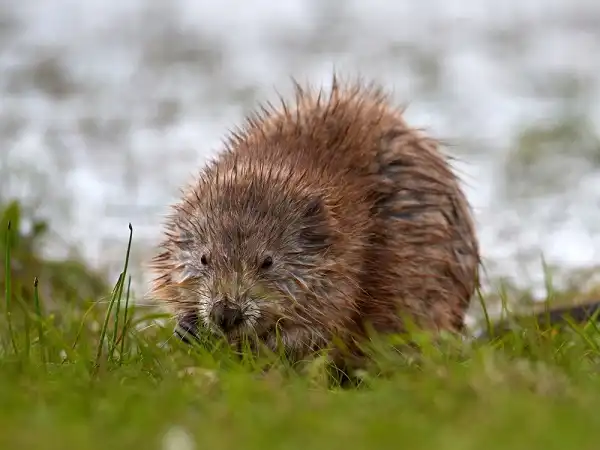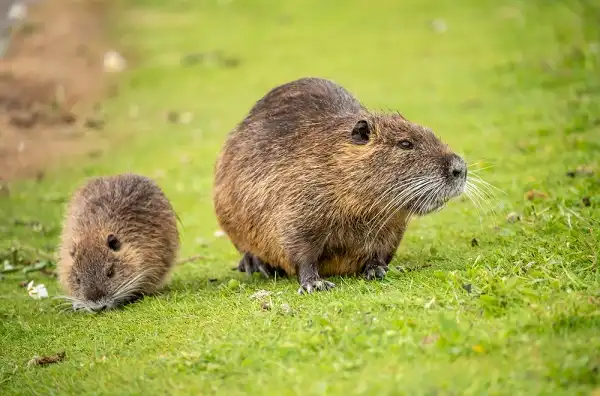Have you ever heard of the muskrat? It may not be a familiar animal, but this fascinating rodent is found in wetlands all across North America. Not only is the muskrat an important part of our environment, it has many interesting facts to uncover – from its unique physical characteristics and behaviors to its place in local cultures and societies. In this blog post, we’ll explore more about these animals so you can gain a better understanding of why they are so important!

Muskrat Description
The muskrat is an aquatic mammal that is found in wetlands all across North America. They are small to medium-sized rodents that have a brownish-black fur coat, which is thick and oily. The tail of the muskrat is flattened and scaly, and its hind feet are webbed for swimming. Additionally, they have short legs and prominent claws on their front paws. Muskrats have long whiskers that help them detect vibrations in the water as they move around searching for food. They also have two scent glands located near their anus, which produce a distinctive scent used to mark territories and attract mates. This smell can be very unpleasant when it gets heated up by the sun or when it gets mixed with other odors.
Muskrat Habitat
The muskrat is an aquatic mammal, which means that its primary habitat is in wetlands. These areas are full of lakes, ponds, rivers, and streams where these animals can find food sources and build their burrows. Muskrats are found across a wide range of climates from very cold northern regions to subtropical climates. They tend to prefer wetland habitats with slow-moving waters as they provide plenty of vegetation for them to feed on and build their homes. The burrows that muskrats construct usually have two chambers, the first being above the waterline and the second below it for extra protection, and they are normally filled with grasses or reeds.
The main entrance to these burrows will be underwater, providing easy access in and out while also helping them conceal themselves from predators. Muskrats will usually build multiple burrows in one area so that if one becomes flooded they have an alternative to move into quickly. Muskrats can also be found living in artificial habitats such as ditches, marshes, canals, and reservoirs. These areas may provide them with more safety than natural wetlands because there are usually fewer predators present. Muskrats will also sometimes occupy abandoned buildings or other man-made structures near water sources, taking advantage of any shelter available to them.
Muskrat Diet
The muskrat is an omnivorous creature, meaning that it feeds on both plants and animals. Its diet consists of a variety of items including roots, tubers, insects, amphibians, fish eggs, and crustaceans. The muskrat is an opportunistic feeder and will take advantage of whatever food sources are available in its wetland habitat. In terms of plant-based food sources, muskrats will scavenge for aquatic vegetation such as reeds, cattails, and sedges. They are also known to consume the roots of various aquatic plants which can be dug up from the muddy bottoms of their chosen habitats. For animal-based meals, muskrats often hunt for small fish, frogs, and other amphibians as well as larger invertebrates like crayfish. Insects such as dragonflies and water striders make up a large component of their diet as well. Additionally, they may chow down on other rodents or birds that are unfortunate enough to wander into their territory.

Muskrat Size
The muskrat is a small to medium-sized rodent that has a brownish-black fur coat. The average length of the muskrat ranges between 11 to 16 inches, with a weight of up to 3 pounds. They have short legs and prominent claws on their front paws as well as long whiskers for detecting vibrations in the water. Muskrats are quite lightweight, and they can even float on the surface of the water due to their oily fur coat! Their tails are also very unique – they are flattened and scaly, providing an efficient way for them to navigate through water. The tail also helps them keep their balance when they stand upright on land or swim in the water. Additionally, their hind feet are webbed for swimming, which makes them excellent swimmers and divers!
Muskrat Lifespan
The lifespan of muskrats depends on a variety of factors including their environment, diet, and predators. On average, muskrats can live up to 3 or 4 years in the wild. In captivity, they can potentially live up to 8 years. The longest-living muskrat ever recorded was 12 years old! The main predators of muskrats are larger animals such as coyotes and foxes. However, humans also pose a threat through hunting and trapping which can reduce the population significantly in some areas. The quality of habitat is also an important factor in determining the lifespan of muskrats. Healthy wetlands provide plenty of food sources as well as some protection from predators – allowing muskrats to thrive and live longer lives. Young muskrats are especially vulnerable to predation during this stage so access to natural shelters such as burrows is essential for their survival.
Muskrat Behavior
Muskrats are highly social animals that live in large colonies of up to 30 individuals. They communicate using a variety of vocalizations and other forms of behavior such as tail slapping, body posturing, scent-marking, and grooming. Muskrats will also use both auditory and visual signals to identify members of their own species. During the day, muskrats are active and forage for food in shallow areas. At night they retreat to the safety of their burrows to rest. These underground dwellings provide protection from predators, as well as help them regulate temperature since air tends to flow more freely along the deeper channels created by muskrats.
Muskrats are territorial creatures and mark out their boundaries with secretions from glands located on either side of their anus which creates a distinct odor. They will also make “runways” through vegetation near the edge of their territories which helps them mark off their area from intruders. Additionally, muskrats can be quite aggressive towards each other when resources become scarce or if there is a lack of space available for living quarters. This behavior can involve physical confrontations or chasing each other away from desirable habitats.

Muskrat Speed
Muskrats are relatively fast mammals, capable of swimming at speeds up to 5 mph. On land they can reach up to 3 mph but only for short distances, usually when running away from predators. They have webbed feet and a flattened tail which helps them move quickly in water, and they use their tails to help steer and maintain balance while swimming. Muskrats are also excellent divers and can remain submerged underwater for up to 15 minutes in search of food or shelter. In order to maximize their speed, muskrats will sometimes run across the surface of the water using their back legs as paddle-like paddles. This technique is known as “water running” and allows them to move faster than if they were simply swimming. Additionally, during colder seasons muskrats may even plunge beneath the icy waters in order to escape from predators or find warmth!
Muskrat Reproduction
Muskrats reach sexual maturity when they are around 1 year old, and the female will typically give birth to a litter of 5-6 young each spring. The juveniles typically stay with their mother for 8-12 weeks before venturing out on their own. During this time, mothers will nurse and teach their young about survival in the wild. The breeding season for muskrats begins in late winter or early spring, with males competing for dominance over a particular area. During this time, females become more receptive to mating and may even be courted by several suitors at once. After successful mating, the female will build a nest out of vegetation which will serve as a home for her young until they are ready to leave it. The gestation period for muskrats is around 28 days and litters generally consist of 4-5 offspring. The newborns are born blind and furless but quickly grow fur within 24 hours and open their eyes within 2 weeks of being born. Once the juveniles reach 8-12 weeks old they start to venture away from the nest and explore their surroundings under adult supervision.
Muskrat Hunting
Muskrat hunting is a popular activity among hunters and trappers. This small animal is hunted for its fur, which has been used to make coats and other apparel items. Hunting muskrats also provides the opportunity to manage their population in an area, as they can be quite destructive to local wetlands if left unchecked. Trapping is the most common way of hunting muskrats, which involves setting traps in areas where the animals are likely to frequent. These traps can range from box traps, conibear traps, live traps, or snares. Once a muskrat is caught in one of these devices it can then be euthanized humanely or released back into the wild if desired. In addition to trapping, muskrats can also be hunted with firearms or bows and arrows. This method requires more skill than trapping since there is a higher chance of missing the target animal and injuring non-target species such as birds or other mammals. It is important for hunters to have knowledge of proper shooting techniques so that accidental shootings are avoided.

Conclusion
Muskrats are an interesting species of rodent that have adapted to live in both terrestrial and aquatic environments. They use their sharp claws, webbed feet, and flattened tail to help them build dens, dig channels, and move swiftly through the water. They also possess a complex vocabulary of communication signals used to communicate with each other and mark out their territories. Additionally, these animals have proven to be resilient hunters. And lastly, they provide a great resource for human hunters due to their abundance of fur for apparel items and food sources.
Frequently Asked Question


